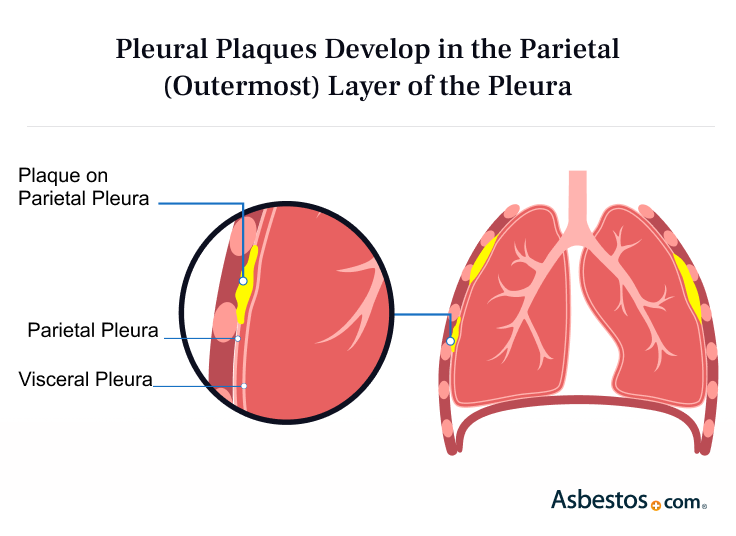Jack Riordan was diagnosed 30 years ago with pleural plaques, an asbestos-related condition. When shortness of breath became an issue, he knew it might be severe. He had spent much of his career working with asbestos insulation, doing asbestos abatement and general contracting. He said of his mesothelioma diagnosis, “I knew this was a possibility a long time before.”
Pleural Plaques and Asbestos
Pleural plaques are the most common sign of asbestos exposure. They’re benign areas of thickened tissue in the lung lining's outer layer. Pleural plaques don't cause mesothelioma or other asbestos-related diseases. But they can signal a greater risk of disease.
What Are Pleural Plaques?
Pleural plaques are thick areas of tissue that form when asbestos fibers get stuck in the pleura, which is the lining around the lungs. These plaques grow on the outer layer of the pleura. They aren’t cancerous, but they can be a warning sign of mesothelioma.
Key Facts About Pleural Plaques
- Pleural plaques aren’t malignant. But they’re a diagnostic factor for pleural mesothelioma.
- CT scans can detect pleural plaques with 95% to 100% accuracy.
- Pleural plaques are usually 2 mm to 5 mm thick and form 20-30 years after exposure to asbestos.
Most people with pleural plaques don’t have symptoms and can live for years without problems, though some feel pain or a grating feeling when they breathe. Doctors also call them “hyaline pleural plaques” because they contain tissue found in cartilage. These plaques form after long-term asbestos exposure and can raise the risk of pleural mesothelioma or asbestos-related lung cancer.
“Asbestos fibers can damage tissue in a local area and cause scarring over time, and that’s called a plaque,” Sean Marchese, RN, tells us. “As plaques develop, they can cause stiffening and harder tissue on the pleura and that restricts the amount of motion that the lungs can use to expand and contract while someone’s breathing”.

How Are Pleural Plaques Caused?
Asbestos exposure causes pleural plaques. When someone breathes in asbestos fibers, the fibers collect in the lining of the lungs and irritate the tissue. The body’s immune system may also react, with special cells called pleural macrophages, adding to the damage. Pleural plaques usually show up 20 to 30 years after exposure.
These thickened areas in the pleura don’t always lead to mesothelioma. However, a 2022 study in the journal Chest found that having pleural plaques on both sides of the chest, along with nodules and fluid buildup, can be signs of mesothelioma.

Connect with trusted specialists who truly care about your health. Get fast, stress-free appointment help.
Find a Doctor NowWhat Are the Symptoms of Pleural Plaques?
Most people with pleural plaques don’t have symptoms, but some feel chest pain or have trouble breathing. These problems often come from asbestos exposure and the harm it causes to the lungs. Sometimes, pleural plaques show up along with other asbestos-related diseases like mesothelioma.
Symptoms of Pleural Plaques
- Chronic coughing
- Coughing up blood
- Trouble breathing
Pleural plaques aren’t as serious as mesothelioma, but they can show that someone had a lot of asbestos exposure. When doctors check breathing problems with imaging scans, they may find pleural plaques or pleural thickening.
How Are Pleural Plaques Diagnosed?
Doctors use imaging scans like X-rays and CT scans to find pleural plaques. Each scan works differently to show if plaques are in the lining of the lungs.
Common Imaging Tests
- CT Scans: A CT scan is the most accurate test for diagnosing pleural plaques. It’s 95% to 100% correct. The test can reveal plaques anywhere in the chest, even if they’re not calcified.
- X-rays: Radiologists find most pleural plaques after an X-ray. This test reveals areas with thickened nodular edges resembling a holly leaf or translucent white deposits on the lungs. In specific locations, these plaques can be difficult to identify via X-ray.
These imaging scans can also find pleural mesothelioma. Doctors often discover mesothelioma or other asbestos-related diseases while checking for other conditions that cause similar symptoms.
Treatment and Management of Pleural Plaques
Doctors usually don’t treat pleural plaques right away unless they start to affect how the lungs work. One reason treatment isn’t needed is that pleural plaques don’t spread like mesothelioma tumors.
People with pleural plaques can keep their lungs healthy with some lifestyle changes. It’s important to talk to a doctor first, but these changes might help.
Lifestyle Changes to Improve Lung Function
- Create and follow a healthy diet plan
- Taking on a routine exercise regimen
- Quit smoking
You can ask your doctor for lung function tests. These tests can help you plan the best way to make lifestyle changes.
“Unfortunately, there’s no great treatment options for pleural plaques. It’s more of a sign of an underlying disease like asbestosis or mesothelioma, that there’s damage happening to that tissue. It’s typically treated symptomatically, which means that breathing treatments or oxygen can help lower the symptoms.”
Common Questions About Pleural Plaques
- Are pleural plaques related to cancer?
-
Pleural plaques are not a form of cancer, although pleural plaques and fibrous thickening may increase your risk of pleural mesothelioma and lung cancer.
- Do pleural plaques increase the risk of developing lung cancer?
-
Yes, pleural plaques can raise the risk of developing asbestos lung cancer. This is because pleural plaques are an indication of prolonged asbestos exposure, which can cause lung cancer.
- What’s the difference between pleural plaques and pleural thickening?
-
Pleural plaques generally form in a small and localized locations. They are noncancerous. Pleural thickening, also noncancerous, is more widespread and more closely associated with a potential pleural mesothelioma diagnosis. Both are linked to asbestos exposure.
- Can pleural plaques lead to other lung conditions?
-
No, but they can raise the risk of more dangerous asbestos-related conditions like mesothelioma, asbestosis and asbestos-lung cancer.





